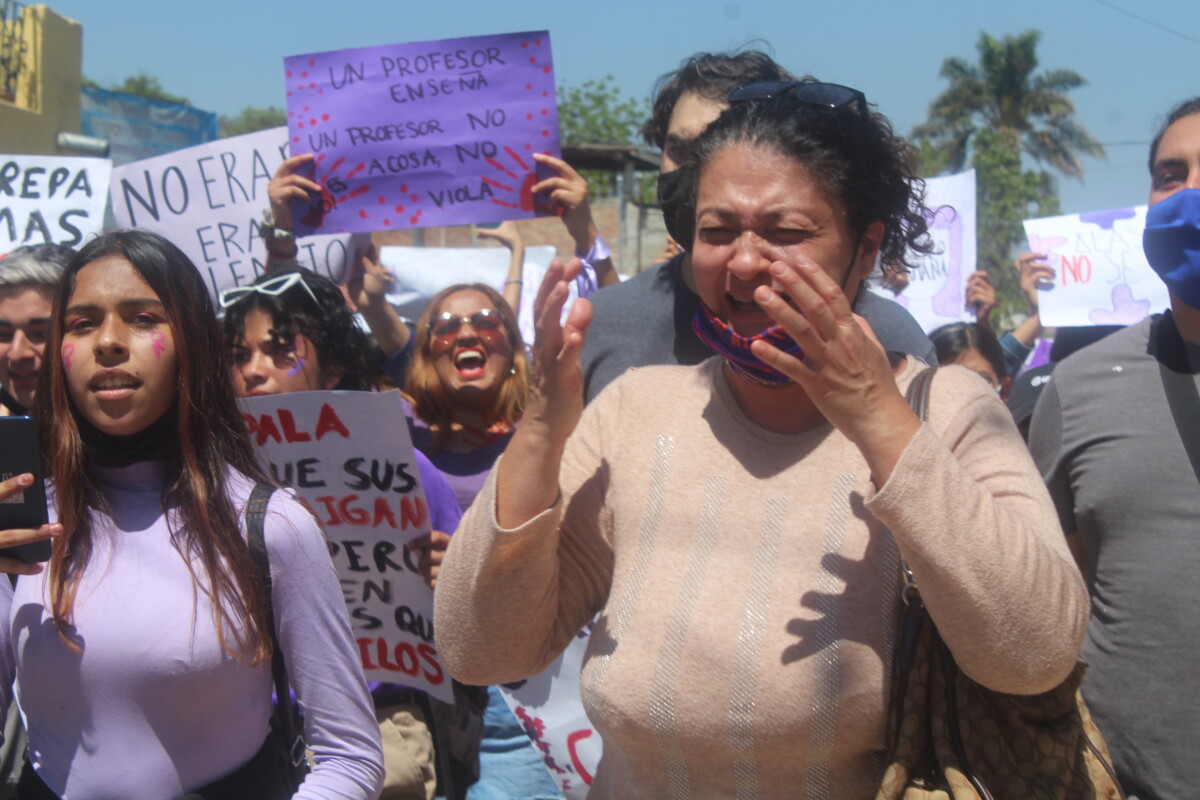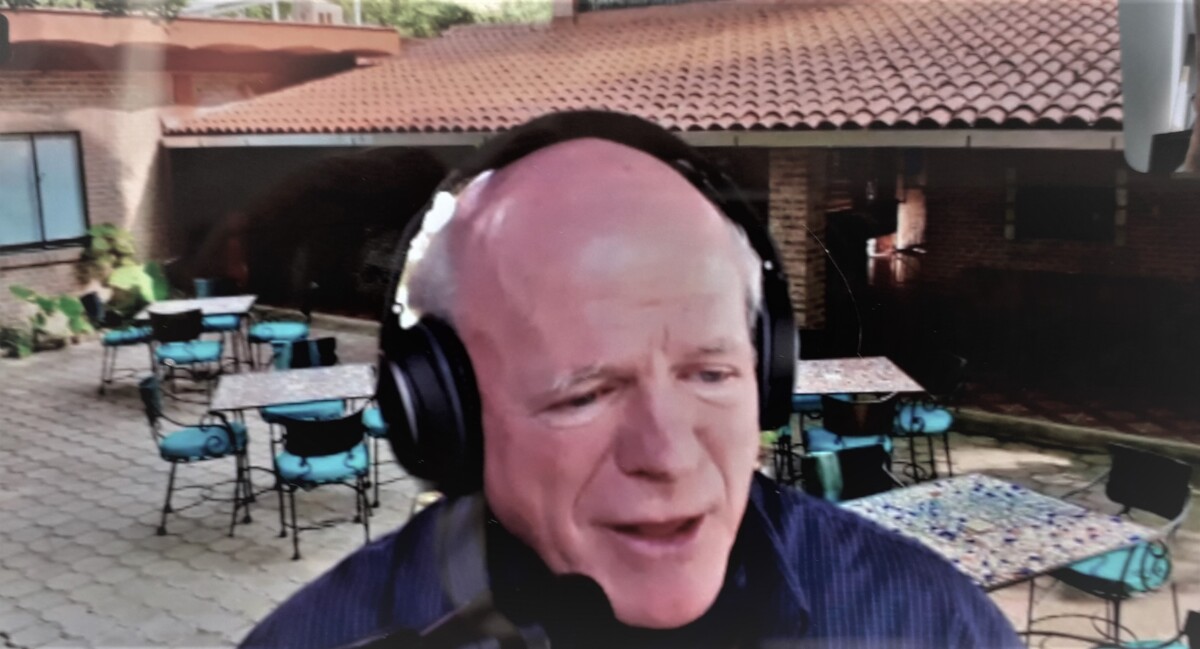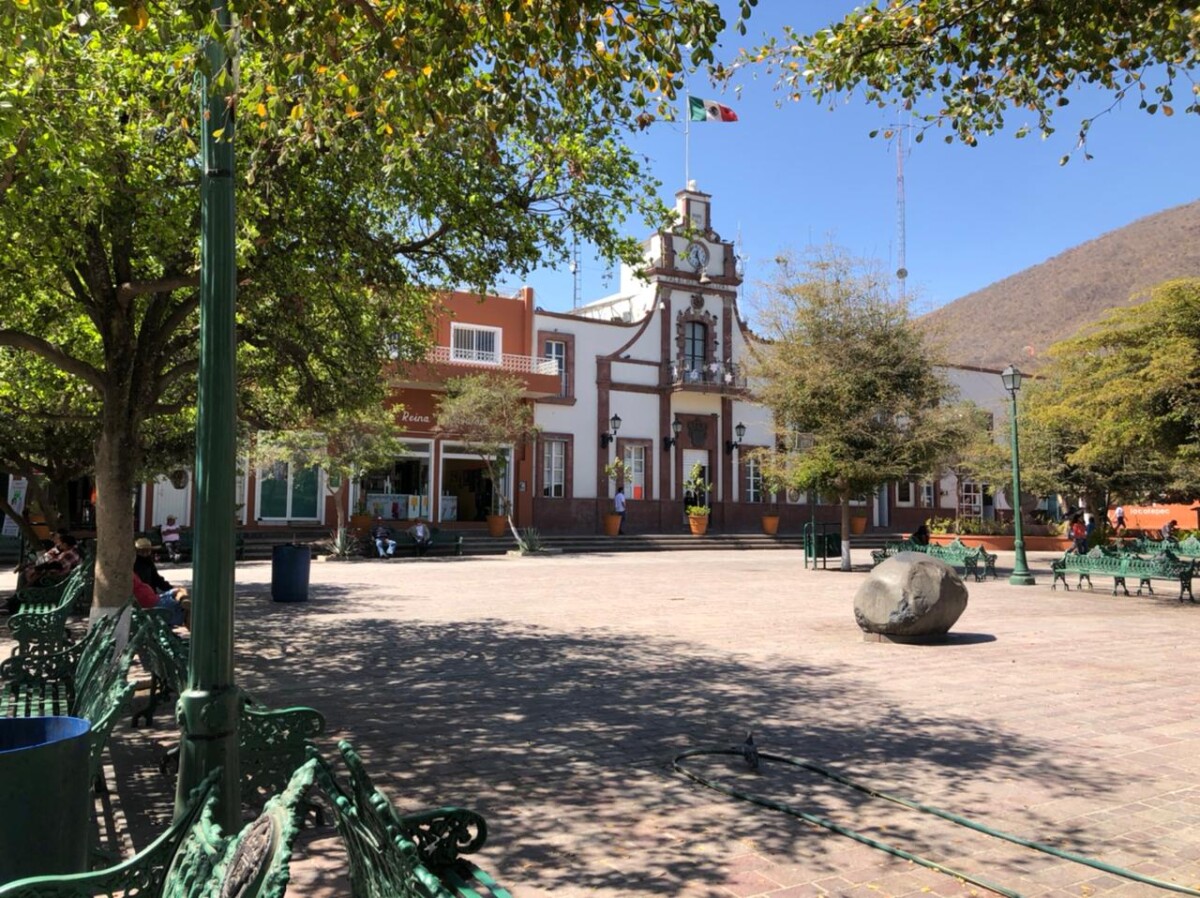Localidades
Call for calm in the face of violence in Jocotepec
Patrol car in which the murdered policemen were being transported.
The violent acts in Jocotepec, as well as in the road that goes to Mazamitla, filled the population with uneasiness and uncertainty, while the authorities made a call to remain calm and not to be victims of disinformation or fall into telephone extortion.
The municipal president of Jocotepec, José Miguel Gómez López, asked people to remain calm and said that people attempting telephone extortion have tried to take advantage of the fear. He exhorted people to hang up the phone if they receive calls attempting to extort them.
Before the murder of the two policemen and the two members of Civil Protection and Firefighters who were wounded, the Governor of Jalisco described the crime as cowardly, saying that there is no risk for the civil society.
«There has been no direct threat to the civilian population, there is no risk that implies suspending classes, there is no municipal authority that has the power to suspend activities,» Governor Enrique Alfaro said in a video.
Translated by Patrick O’Heffernan
After a street demonstration against his alleged sexual abuse, professor voluntarily resigns
The mother of the victim involved in screaming and crying during the demonstration.
Jazmín Stengel (Chapala).- After the demonstration called by Daniela Baéz, the former student of the Chapala Regional High School who accused him of sexual abuse, a professor voluntarily resigned from the institution, while the University of Guadalajara (UdeG) stated that it will investigate the case.
The protest held on March 14, began at the school campus, traveled along the main avenue of Chapala, Francisco I. Madero, and ended in front of the City Hall building; Approximately 200 people attended with homemade signs, shouting slogans demanding justice .
The dozens of demonstrators shouted «David harasser, Ramón cover-up», referring to the Professor and to the head of the school where the alleged abuse occurred. They also chanted, «The school does not take care of me, my friends take care of me», as they marched carrying banners reading : «Teachers or Pigs?», «Reputation is more important than the safety of the students» and «I want to study without fear», among other messages.
A communiqué issued by the University of Guadalajara (UdeG) on March 15, the day after the demonstration stated that «The professor indicated has voluntarily stepped down and will remain away from his duties until the investigations are concluded.”
In the document, the University emphasized that it had communicated with the affected student, as well as her family, to offer them advice, support and a guarantee to carry out the due process.
It was only on Wednesday, March 16, that the victim announced on social networks that she had formally filed a complaint with the Public Prosecutor’s Office, as well as with the Office for the Defense of University Rights (DDU), an agency of the highest university in Jalisco.

The victim during the demonstration, at the end of her interviews with the media.
During the March 14 march, not only the name of Professor David was heard, but also that of four other teachers from the same high school; however, the director of the Municipal Institute for Women, Alicia Medeles Córdova, declared that this is the only case that has been followed up so far.
The teacher was pointed out by a former student for alleged acts of sexual abuse when she was 15 years old, seven years ago, in 2015. Daniela uploaded a publication describing her case in her social networks.
In what the young woman has publicly disclosed is that the v50-year old teacher David took her on seven occasions over a nine-month period to two houses he rented in the Plaza de Toros and Chapala Haciendas neighborhoods.
«He would place us naked in front of a computer and touch me or make me touch him. He probably has photos and/or video of us (because the camera always had the light on) «After the first encounter I went to the high school psychologist, Anel Padilla, to tell her EVERYTHING, because she was confused. Her answer was «that if we both wanted to, then it wasn’t bad».
Today I understand that whether you want to or not, it IS A CRIME. Fortunately at the last meeting a relative of his wife saw us enter the house and went to look for my mom. A letter was filed in the high school, to leave a record. However, in order to «take care» of me and my «prestige» nothing was done», the young woman wrote in the filed letter .
Laguna contacted the professor to request an interview, but the University of Guadalajara forbade him to talk about the case until the investigations were concluded.
Translated w by Patrick O’Heffernan
Photo Caption:
Photo Credit: Arturo Ortega
Despite last year’s good weather, so far in the dry season, Lake Chapala has lost 44 centimeters of water. It is currently at 69% of total capacity. The average reservoir volume in the state of Jalisco is 80%.
Translated by Amy Esperanto
LCS Annual General Meeting is a “State of the Union” for LCS
LCS Chairman Stephen Balfour conducts a hybrid live and zoom Annual General Meeting from the terrace of LCS. (screen shot)
Patrick O’Heffernan (Ajijic).- The Lake Chapala Society’s Annual General Membership meeting held Tuesday, March 15, was a “state of the union” for one of Lakeside’s largest and most influential non-profit organizations. According to Board Chair Stephen Balfour who led the hybrid live/ zoom meeting.
After a highly produced video tour hosted by Balfour and Executive Director Luis Pacheco with cameos by members of the LCS staff, the Annual Membership Meeting ( AGM) was called to order with 83 people in attendance online and in person at the LCS campus in Ajijic. The tour covered the grounds of the campus and the many improvements that have taken place over the past 723 days since the last in-person AGM.
Highlights of the near 2-hour long meeting included reelection of the existing Board members, election of Choosing Mexico CEO Greg Custer for an at-large Board seat, the introduction of the Mexican Advisory Council led by Cruz Roja Chair Yolanda Martínez Llamas, the renaming of the LCS docents as “LCS Amigos”.
Balfour and new Executive Director Pacheco, the Mexican to run the organization, took the members through the challenges and the accomplishments of the past 723 days, noting that for a while the work of the staff was focused solely on keeping the doors open as membership plummeted by 40% due to Covid.
To pay the bills and keep the staff working, Balfour used his experience as a concert producer in the US to launch the Concerts in the Park series at LCS which raised $2.2 million pesos for LCS and $1 million for Cruz Roja. Additional restricted funds were raised from major donors to purchase the Molenari/West Annex property in November of last year. That combined with $3million pesos in increased donations offset the loss of program income and much dues income to enable LCS to stay open, purchase an adjacent property, and refurbish much of the grounds.
Balfour reported that visitation is up to 1000 a week now, with 40,000 people coming through the doors last year, an indication that the members are returning and engaging in the 100 programs now operating at LCS.
The AGM also included a financial report to the members, informing them that LCS’s financial condition is good, with a cash reserve of $850,000 and an operating deficit of $14,395 which was necessary to complete necessary repairs and maintenance, and a net asset valuation of $30 million.
The final segment of the AGM was dedicated to LCS 2.0, the plan developed and approved by the Board to guide the next decade of LCS. Balfour stressed that he wants LCS to be known for “customer service” . He also listed other priorities as a closer relationship with the Mexican community, continuing to strengthen the bonds with the Instituto Tecnológico Superior De Chapala , and broadening fundraising through innovations like new, smaller, flexible-use “named” tables members can sponsor for $6000 pesos.
The 2022 budget projects $7,009,100 MX in expenses and revenue, with annual dues remaining unchanged from the current $830MX a year for singles and $650nMX for persons age 79 and over in 2022.
President Aguirre Kicks Off “Miércoles Contigo” (“Wednesdays Together”) Program in Plaza de Toros
The president of Chapala, Alejandro de Jesús Aguirre Curiel, listening to the complaints of a local citizen.
Jazmín Stengel (Chapala).– More than fifty residents of the Plaza de Toros neighborhood came to the first «Miércoles Contigo,» a new program where the president of Chapala, Alejandro de Jesús Aguirre Curiel, and his cabinet will listen to the complaints and needs of different neighborhoods within the Chapala municipality.
The program, which was one of his campaign promises, began on March 16th. At the first event, water and unsatisfactory lighting, and garbage were among the most recurrent complaints. There were also requests to change the schedule of the little square to close it at night (for safety concerns), as well as the different workshops that the neighbors wish to give to the children of the area.
According to neighbors, the water shortage has gotten worse since the removal of the stone cistern during the administration of a previous president of Chapala, Jesús Cabrera Jiménez (2010-2012). The cistern had been located in the now small square on Colinas del Manglar.
In response to complaints about the garbage problem, the officials promised to install a large sign informing everyone that garbage should not be left in the small square. This will hopefully prevent people from outside the neighborhood from leaving their garbage in the square.
The purpose of the «Wednesdays Together» program is to listen to the needs of residents so that directors of the various municipal agencies can better solve the problems of each neighborhood, both in Chapala, as well as in the towns and villages that make up the municipality.
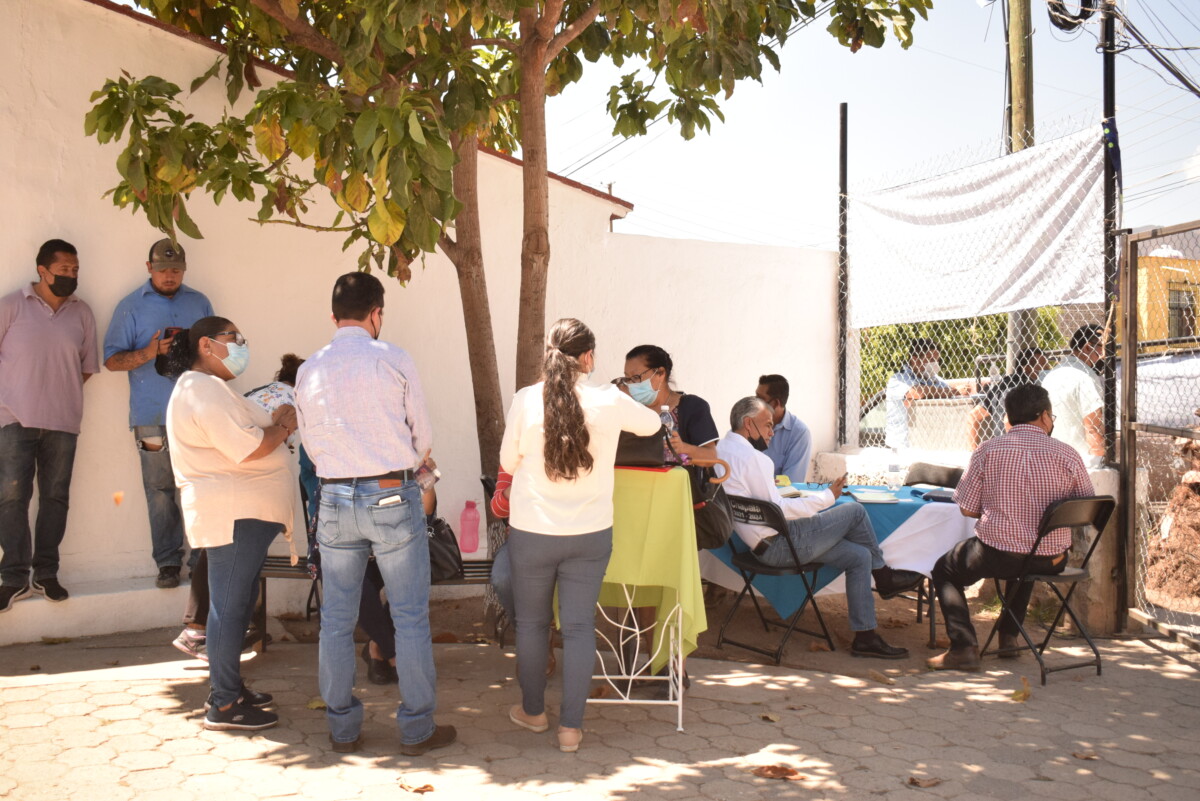
Inside the small square, public officials listening to complaints from citizens
«The main function of government is to be in the street with the people, to address their concerns and needs,» said President Alejandro de Jesús Aguirre. He personally attended to each person’s issue, and then referred them to the appropriate municipal official. It is expected that this will be the way it works every week, said the officials who were interviewed.
At the event, each person who wanted to speak received a numbered card, and a form to write down their complaints, recommendations, and their contact information for follow-up. This three-copy form was distributed as: one to the president, one to the official of the corresponding agency, and one to the citizen
The aldermen present took responsibility to form a neighborhood committee to be in contact with the neighborhood, and follow up on the needs, and requests made. The full calendar of the «Wednesdays Together» program will be announced in the next few days.
Also present at the event were: General Secretary Lilia Alvarado Macías, Trustee Gamaliel de Jesús Soto Pérez, Commissioner of Public Safety, Sergio Conzuelo Ramírez, Head of the Fire and Civil Protection Unit, Lorenzo Antonio Salazar Guerrero, Head of the Municipal System of Potable Water and Sewage (SIMAPA) Chapala, Fernando Antonio Monreal Mendoza, Head of the Women’s Institute, Alicia Medeles Córdova, among other public officials.
Translated by Amy Esperanto
OPINIÓN: EL GRITO EN LA LAGUNA
Lago de Chapala. Foto: Hector Ruiz
Por: Daniel Jimenez Carranza
Uno de los factores definitivos que juega un papel relevante en todas las sociedades es la regulación de su crecimiento, el cual en nuestro país no ha sido considerado con la suficiente seriedad como tal, existe una figura administrativa dentro de la organización de los Ayuntamientos, como es la oficina, departamento o dirección de desarrollo urbano la cual en la mayoría de los casos, únicamente se dedica a “regular el tipo de construcciones”, que en muchos casos no cumplen completamente con los lineamientos contenidos dentro del Plan de Desarrollo Urbano de la localidad, y cuyos criterios al momento de autorización de construcciones, son bastante elásticos, dependiendo de múltiples factores como son los económicos, políticos y de amiguismo. En otros casos, los lineamientos no son lo suficientemente claros y precisos, que propician en el mejor de los casos, un desorden de las construcciones en la localidad y en otros, lamentables accidentes por las características del suelo y construcciones inapropiadas.
Todo ello, sin embargo, es sólo un aspecto de tantos otros que deben ser considerados en el control del desarrollo urbano, como son los recursos de la localidad tanto humanos como materiales, las instalaciones, equipo e infraestructura, la distancia hacia los centros de consumo y de producción, características de la población, etc., todos estos factores permitirán realizar un plan integral realista que aporte bienestar a la comunidad, que regule el crecimiento de la población y que permita la conservación del ecosistema entre otros importantes aspectos.
La unidad de desarrollo urbano, debe estar integrada por diferentes especialistas cuyas aportaciones incidan y regulen el propósito enunciado, protegiendo el interés común y propiciando un desarrollo claramente concebido y coherente para ese propósito.
La falta de un plan integral, trae como consecuencia, múltiples disfunciones sociales, ecológicas, arquitectónicas, asi podemos observar construcciones monumentales a la orilla del lago, totalmente inapropiadas, desarrollo de actividades ganaderas en zonas residenciales, como es el caso del terreno localizado en la calle Río Chamela, en Rancho del Oro, supuestamente propiedad del Gobierno del Estado que contribuye a crear un aspecto reprobable de espacios improvisados con plásticos superpuestos, que generan basura al interior y exterior del terreno, desconociendo que una institución de tal calibre comercie con el alquiler de una propiedad oficial para este propósito, aunque de acuerdo con el Plan Parcial, ello es una zona mixta que permite esta actividad, que aún justificada, desconocemos quien lucra y se beneficia de ellas.
Tratándose de un activo del Estado, el Ayuntamiento tendría que gestionar la donación del terreno para un mejor propósito que beneficie al municipio, como la construcción de un campo deportivo, parque de usos múltiples, particularmente importante para un país con una población juvenil considerable y gran déficit de instalaciones para este grupo.
Alfaro da banderazo e inaugura obras en Jocotepec
El Gobernador de Jalisco, Enrique Alfaro Ramírez, en compañía del presidente municipal de Jocotepec, José Miguel Gómez López y la diputada local, María Dolores López Jara, dando el banderazo de inicio de obra del libramiento. Foto: Héctor Ruiz.
Héctor Ruiz Mejía.- El gobernador de Jalisco, Enrique Alfaro Ramírez, realizó un recorrido el pasado 25 de marzo por distintos puntos de la Ribera de Chapala, entre ellos, Jocotepec.
Durante su visita, Alfaro Ramírez inauguró el Centro de Salud de San Cristóbal Zapotitlán, cuyo costo fue de 10 millones de pesos.
También supervisó la última etapa de la ciclovía que conectará a San Juan Cosalá con la cabecera y que concluirá en mayo. La inversión total de la vía recreativa que conectará a Chapala y Jocotepec, representó un gasto de 211 millones de pesos.
Asimismo, el gobernador dió el banderazo de arranque para las obras del libramiento con la rehabilitación en sus 5 kilómetros de extensión con una inversión de 30 millones de pesos.
Enrique Alfaro calificó esta carretera como “la historia de las obras mal hechas”, por lo que se comprometió a dar ahora sí, una solución al accidentado tramo que comprende cinco kilómetros. .
Anuncia Gobernador entrega del Auditorio de la Ribera en 4 meses
Enrique Alfaro Ramírez durante su última visita a la Ribera de Chapala. Foto: Sofía Medeles.
Sofía Medeles.- El gobernador de Jalisco, Enrique Alfaro Ramírez anunció que faltan solo cuatro meses para que se culminen los trabajos en el Auditorio de la Ribera, ubicado en la delegación de Ajijic, durante su última gira por la Ribera de Chapala, el 25 de marzo.
En total, la tres etapas de la remodelación del recinto, junto a la construcción de los edificios, tuvo una inversión aproximada de 70 millones de pesos, y fue parte del proyecto llamado «Cultura Cardinal» que pretende descentralizar la cultura de Jalisco con clases de diferentes disciplinas, oficinas de la Secretaría de Cultura, y presentaciones culturales en el auditorio.
Por otro lado, el equipamiento mobiliario del auditorio, no se encuentra dentro de los 70 millones de pesos, según lo que comentó Alfaro Ramírez, quien también agregó que ya se encuentran buscando maneras de financiarlo.

El gobernador, junto con autoridades municipales, supervisaron los avances de la obra. Foto: Sofía Medeles.
Jocotepec ranks third in the state in job losses
Although the statewide trend was of job recovery, in Jocotepec jobs went down. Photo: Héctor Ruiz.
Staff.– Jocotepec was one of the municipalities in Jalisco that lost the most formal jobs during the month of February 2022, according to data from the Institute of Statistical and Geographic Information of Jalisco (IIEG).
According to the IMSS database of insured workers, the Lakeside town ranked third on the list of the 125 municipalities in the state with the greatest loss of formal employment during the past month.
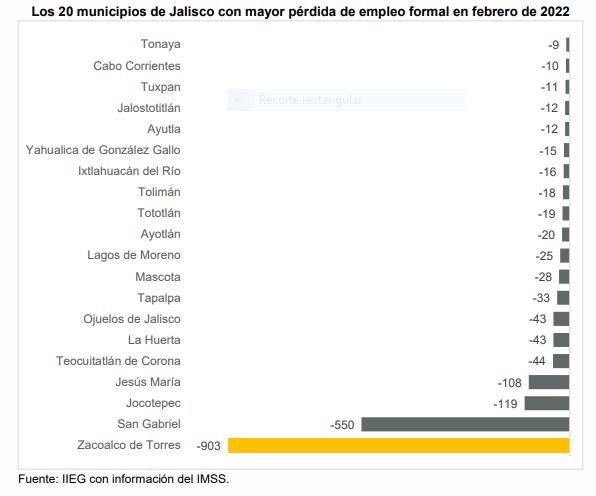
Together with Zacoalco de Torres and San Gabriel, Jocotepec registered the greatest loss of formal jobs during February 2022. Photo: Special.
In first place was Zacoalco de Torres with 903 workers laid off, followed by San Gabriel with 550 and in third place was Jocotepec with 119 jobs lost.
In contrast, the three municipalities that generated the most formal employment during February were Zapopán with 4,488 workers, Tlajomulco de Zúñiga with 1,618 and Guadalajara with 1,106.
At the state level, Jalisco registered an increase of 13,463 formal jobs in February 2022, mainly from the processing industries.
Translated by Sandy Britton
Jocotepec kiosk adapted to accommodate street vendors
On one of the sides of the kiosk, metal windows have already been placed that will serve as a work table for the vendors.
The kiosk located in the center of the main square in Jocotopec, one of the icons of the town, will be adapted to accommodate street vendors.
Construction work began last week, taking advantage of the space inside the kiosk, presumably to relocate the two stands that sell fruit next to the municipal DIF.
So far, only two openings have been made in two of the sides for the installation of a metal window on each side, which can be folded down to serve as tables to display the products. City Hall personnel working on the project explained that they also plan to divide the internal part of the kiosk in two.
«I am only making the two windows, but I understand that a wall will be erected to divide it in two and create two stores,» commented one of the workers.
Felipe Aguilar Montes de Oca, Director of Social Communication, confirmed that the project to relocate one of the stalls is being carried out.

The construction of the kiosk dates from the middle of the last century and was intervened for the only time during the 2004-2006 administration.
«Work is continuing on inside the kiosk for the fruit vendor who has yet to be relocated. As far as I know, it is for the one who has been selling here in the plaza for the longest time.»
The director was asked for the budget to be used for the project, which is being managed by the General Secretariat in coordination with Public Services, but there was no response.
With this measure, the Municipality of Jocotepec seeks to improve the urban image of the center of the city, with the relocation of the street vendors from the vicinity of the square and the streets surrounding the market.
Jocotepec’s kiosk dates from the middle of the last century and was remodeled only once during the administration of Jesús Palos Vaca (2004-2006). Since then, it has remained as it is currently known.
Translated by Sandy Britton
© 2016. Todos los derechos reservados. Semanario de la Ribera de Chapala

